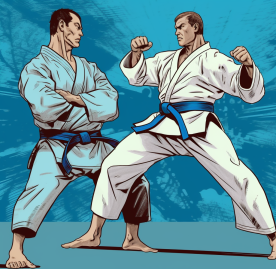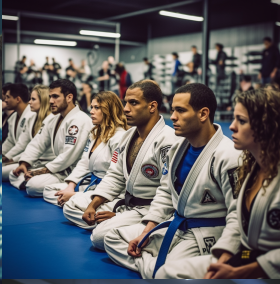If you just started your Brazilian Jiu-Jitsu (BJJ) journey or are considering it, you might find yourself wondering about the meaning behind those differently colored belts. What do they represent? And more importantly, what do you need to do to earn them? Don’t worry; you’re not alone in these questions.
In BJJ, the belt system is a visual representation of a practitioner’s skill, knowledge, and experience. It plays a significant role in tracking your progress and setting new goals. But more importantly, it paints a picture of your evolving abilities as a grappler. Let’s demystify these belts and answer the crucial question: “What do these belts truly mean?”
II. History of the Brazilian Jiu-Jitsu Belt System

A. Origins of the BJJ Belt System
The Brazilian Jiu-Jitsu belt system traces its origins to Judo’s belt ranking system, introduced by Judo’s founder, Jigoro Kano. Kano established this system to visibly differentiate students’ levels of expertise, a concept that resonated with the founders of Brazilian Jiu-Jitsu.
B. Influence from Judo’s Ranking System
When brothers Carlos and Hélio Gracie developed Brazilian Jiu-Jitsu in the early 20th century, they recognized the effectiveness of Kano’s belt system in structuring students’ progression. Consequently, they integrated a similar system into their newly formed martial art, leading to the birth of the BJJ belt system as we know it today.
III. Demystifying the BJJ Belt System: A Simple Overview

A. Belt Colors and Their Meaning in BJJ
BJJ practitioners progress through several belt colors, each representing a different stage in their martial arts journey:
- White belt: This is the beginner’s belt and marks the starting point in the journey of learning BJJ.
- Blue belt: A significant milestone, the blue belt signifies that a practitioner has gained a solid understanding of basic BJJ techniques and can successfully counter instinctive responses.
- Purple belt: Often regarded as a transition belt, the purple belt represents a practitioner’s progression towards advanced technical knowledge and signifies a dangerous ability in at least one submission technique.
- Brown belt: The brown belt represents refinement and sophistication of techniques. A brown belt practitioner is often perceived as being highly skilled, possessing comprehensive knowledge and sharp execution.
- Black belt: This belt is the epitome of expertise in BJJ. A black belt holder has mastered the art of BJJ, exhibiting deep knowledge, high-level skills, and an ability to counter sophisticated reactions.
- Red/Black and Red belts: These belts, often termed as the grandmaster’s belts, represent a lifetime devoted to the study and practice of Brazilian Jiu-Jitsu.
B. The Role of Stripes in the BJJ Belt System
Stripes in BJJ are akin to mini-promotions, signifying progress within a belt level. They are meant to motivate students and keep track of their progress before advancing to the next belt color.
C. Age-Specific Belts in BJJ
BJJ also incorporates age-specific belts to ensure that children and juvenile practitioners progress at a pace suitable for their age and physical development.
IV. What does each BJJ belt mean? An In-Depth Look
Let’s dive deeper into exactly what each colored belt means in Brazilian jiu jitsu.
White Belt: The Beginner

The white belt is the first belt that you get in BJJ. As such, it just means you’re a beginner.
Blue Belt: Counteracting Primal Reactions

The first belt after white is the blue belt. Blue belts have learned to counter primal, instinctive reactions to their techniques. For example, if they initiate a single leg takedown, they know how to respond effectively to their opponent’s movements, whether it’s an attempt to move away, lean into the practitioner, or apply force on their shoulders, arms, or face.
A blue belt has mastered approximately 50 essential techniques – those vital for being an all-round grappler, capable of submitting opponents in any situation and escaping from any base position. Based on our observations, most practitioners typically spend a bit over 2 years to earn a blue belt due to the sheer volume of knowledge and practice required.
Purple and Brown Belts: From Basics to Mastery

The purple and brown belts represent the transitional phase from learning the basics (blue belt) to achieving mastery (black belt). They can be likened to the stripes on a white belt – affirmations that the practitioner is on the right track.

A typical purple belt practitioner has honed at least one submission to a black-belt level, becoming a significant threat to higher-ranking practitioners with this move. On the other hand, brown belts usually have five techniques in their arsenal that they can execute with deadly proficiency. Furthermore, they have considerably elevated their overall game, being able to suppress beginners’ moves even before they take shape.
Black Belt: Mastery Over Sophisticated Reactions

A black belt symbolizes an expert practitioner who has learned to defeat other sophisticated opponents. Their training enables them to handle complex reactions that a less experienced grappler wouldn’t consider. For example, a black belt knows how to react quickly and effectively when an opponent attempts to break their grip during a single-leg takedown.
Reaching this level of mastery requires a comprehensive knowledge of approximately 250 techniques, some of which are considered non-essential and complex for lower belt practitioners. The journey from blue to black belt involves continually refining counters to the increasingly sophisticated reactions of opponents, hence demanding a much higher level of dedication and skill development.
Additional Values Attached to Belts
Beyond the skill progression, belts in BJJ often carry additional connotations, varying by gym and community:
- Competition: Some gyms encourage or require their students to compete and win in tournaments to progress through the belt ranks, viewing competition as the ultimate test of skill. This is common in Checkmat gyms.
- Self-defense: Other gyms focus on self-defense, requiring students to learn and demonstrate techniques for real-life scenarios. Rickson Gracie gyms are known for this focus.
- Teaching: Certain gyms, like the Rickson Gracie gym in Amsterdam, require their students to demonstrate their ability to explain their techniques effectively before earning their blue belt.
- Strength & Conditioning: While less common due to BJJ’s emphasis on technique over strength, some practitioners value physical conditioning and incorporate it into their training regimen.
Each practitioner can also choose to focus on their personal values within their belt journey, which contributes to the richness and diversity of BJJ styles across the globe.
V. Progression in the BJJ Belt System: How to Climb the Ranks

A. Factors Affecting Promotion in BJJ
The journey to a higher belt in BJJ is a nuanced process influenced by:
- Skill level: Mastery over techniques, understanding of concepts, and ability to execute moves effectively.
- Competition performance: Some academies may consider performance in BJJ tournaments.
- Time spent at each belt: A minimum time requirement at each belt level is often expected.
- Teaching ability: One’s capacity to impart knowledge and techniques to less experienced practitioners.
- Character and attitude: Upholding the values of BJJ, such as respect, humility, and discipline, is also essential.
B. Typical Time Spent at Each Belt Level in BJJ
The time spent at each belt level in Brazilian Jiu-Jitsu varies greatly and is often dependent on individual progress. However, on average, it takes about 1-2 years to progress from white to blue belt, another 2 years to reach purple, 1-3 years to achieve brown, and an additional 1-3 years to earn a black belt.
The table below provides a rough estimate of the average time practitioners take to progress through the belts. Remember, these are just averages. The actual time can vary widely based on individual dedication, talent, training frequency, and the gym’s promotional standards.
| Belt | Average Time to Achieve |
|---|---|
| White to Blue | 2-3 years |
| Blue to Purple | 1.5-3 years |
| Purple to Brown | 1.5-3 years |
| Brown to Black | 1-3 years |
C. Belt Testing vs. Informal Recognition in BJJ
Some BJJ schools employ formal testing for belt promotions, while others opt for informal recognition, promoting students based on their performance during regular training sessions and sparring.
VI. The Significance of the BJJ Belt System

A. Personal Development and Growth in BJJ
The journey through the BJJ belt system fosters personal development and growth. It encourages setting and achieving goals, instills discipline, improves physical fitness, and fosters mental toughness.
B. Recognition of Skill and Dedication in BJJ
Earning a new belt in BJJ is a recognition of skill, dedication, and time committed to mastering the art. It symbolizes not only technical prowess but also the journey, the perseverance, and the indomitable spirit of the practitioner.
C. The BJJ Belt System: Fostering Community and Respect
The BJJ belt system also promotes a sense of community, respect, and camaraderie among practitioners. It establishes a hierarchical structure that encourages respect for those who have walked the path longer and guidance for those who are newer to the journey.
VII. Answering Your Burning Questions about the BJJ Belt System
A. How Long Does it Take to Get a Black Belt in BJJ?
The journey to a black belt in BJJ is a lengthy process, typically taking about 9-12 years. However, this timeline varies greatly depending on factors like frequency of training, personal aptitude, and the standards of the particular BJJ school.
B. Can You Skip Belts in BJJ?
In Brazilian Jiu-Jitsu, skipping belts is highly uncommon and generally discouraged. The system is designed to ensure practitioners develop a comprehensive understanding and skill set at each level before progressing. One exception is that black belts in Judo and high level wrestlers are often awarded their blue belt very quickly, due to their experience in a similar grappling sport.
C. What is a Coral Belt in BJJ?
A coral belt (red and black) in BJJ is an honor bestowed upon black belts who have made significant contributions to the art of Brazilian Jiu-Jitsu. After the coral belt, the highest ranking is the red belt, a symbol of a lifetime dedicated to BJJ.
D. Why Are BJJ Belts So Hard to Achieve?
BJJ belts are hard to achieve due to the high level of skill, knowledge, and experience required at each level. The BJJ belt system is designed to ensure that a practitioner is fully prepared for the challenges that each new belt presents.
E. Is a Blue Belt in BJJ Dangerous?
While the term “dangerous” may be subjective, a BJJ blue belt has a solid understanding of fundamental techniques and can effectively counter untrained individuals or practitioners from non-grappling martial arts. However, their intent should always be self-defense and promoting the discipline and respect BJJ instills, not to cause harm.
F. Could a BJJ Blue Belt Defend Themselves Against an Unarmed Opponent?
In most cases, yes. The skills and techniques learned by the time a practitioner reaches the blue belt level are usually sufficient to handle an unarmed, untrained opponent effectively.
G. Could a BJJ Blue Belt Stand a Chance Against a Boxer or Karateka?
While BJJ is an effective self-defense martial art, a BJJ practitioner’s success against a trained striker (like a boxer or karateka) depends largely on the situation, especially considering that BJJ emphasizes ground fighting while boxing and karate are stand-up fighting styles.
H. Could a BJJ Blue Belt Cause Serious Harm or Even Kill Someone?
While it’s certainly possible given the nature of BJJ’s submission techniques, it’s crucial to note that the philosophy of BJJ prioritizes control over harm. The ethos of BJJ teaches practitioners to subdue opponents without causing unnecessary harm. BJJ is about self-defense, discipline, and respect for others’ safety and well-being.
VII. Conclusion
A. The Importance of the BJJ Belt System for Beginners
The BJJ belt system is an integral part of your BJJ journey, especially as a beginner. Understanding what each belt signifies helps you set realistic goals, understand the path ahead, and appreciate the depth of learning that Brazilian Jiu-Jitsu offers.
B. Embrace Continuous Learning and Respect the Process in BJJ
Progressing through the belts in BJJ is a rewarding yet challenging endeavor. Each belt represents a milestone in your growth, not just as a grappler, but also as an individual. While the path is demanding, the improvements in strength, mental toughness, strategic thinking, and self-discipline are truly transformative.
As you navigate this journey, keep in mind that every expert was once a beginner. Stay patient, remain consistent, and most importantly, enjoy the process. And remember, the more you learn, the more you realize there is to learn. It’s the beauty of BJJ that keeps us engaged and fascinated.
VIII. Bonus: Get a Jump Start on Your BJJ Journey
If you’re ready to fast-track your progress in BJJ, we have something special for you. Sign up today to receive our exclusive guide: “7 Best Tips to Learn BJJ Super Fast.” This valuable resource is packed with practical tips and strategies to accelerate your learning curve and make your time on the mat more productive.
